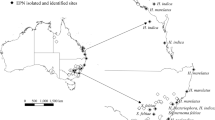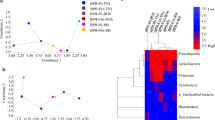Abstract
Many weevils are known as notorious devastating agricultural pests and generally associated with symbiotic bacteria. Here, we investigated the following pest and non-pest weevils collected in Japan for their bacterial associates: the banana stem weevil Odoiporus longicollis (Olivier); the Asiatic palm weevil Rhabdoscelus lineaticollis (Heller); the red palm weevil Rhynchophorus ferrugineus (Olivier); the Japanese giant weevil Sipalinus gigas (Fabricius); the olive weevil Pimelocerus perforatus (Roelofs); the black hard weevil Pachyrhynchus infernalis Fairmaire; and the Yonaguni hard weevil Metapocyrtus yonagunianus Chujo. Bacterial 16S rRNA gene was amplified by a polymerase chain reaction (PCR) from all the weevils, and genotyping and sequencing of the PCR products revealed that Nardonella, an ancient weevil-associated endosymbiont lineage, is the dominant bacterial associate for them. Molecular phylogenetic analyses based on bacterial 16S rRNA and groEL gene sequences showed that the weevil endosymbionts are placed within the Nardonella clade in the γ-Proteobacteria. The phylogenetic relationship of the Nardonella endosymbionts was concordant with the systematics of the weevil hosts, favoring the hypothesis of weevil-Nardonella co-speciation over evolutionary time. In situ hybridization visualized localization of the Nardonella endosymbionts in the larval bacteriome at the foregut-midgut junction in R. ferrugineus and S. gigas, and in the ovarial tips of adult females in O. longicollis. Our results highlight the general relevance of the Nardonella endosymbionts to the biology, control and management of these and other pest weevils.



Similar content being viewed by others
References
Alonso-Zarazaga MA, Lyal CHC (1999) A World Catalogue of Families and Genera of Curculionoidea (Insecta: Coleoptera) (excepting Scolytidae & Platypodidae). Entomopraxis SCP, Barcelona
Aman N, Kurogi S, Nakamura M, Goto H (2000) Occurrence of the red palm weevil, Rhynchophorus ferrugineus, in Miyazaki Prefecture. Kyushu Pl Prot Res 46:127–131 (in Japanese with English summary)
Amann RI, Binder BJ, Olson RJ, Chisholm SW, Devereux R, Stahl DA (1990) Combination of 16S rRNA-targeted oligonucleotide probes with flow cytometry for analyzing mixed microbial populations. Appl Environ Microbiol 56:1919–1925
Buchner P (1965) Endosymbiosis of animals with plant microorganisms. Interscience, New York
Conord C, Despres L, Vallier A, Balmand S, Miquel C, Zundel S, Lemperiere G, Heddi A (2008) Long-term evolutionary stability of bacterial endosymbiosis in Curculionoidea: addiotional evidence of symbiont replacement in the Dryophthoridae family. Mol Biol Evol 25:859–868
Edgar RC (2004) MUSCLE: multiple sequence alignment with high accuracy and high throughput. Nucleic Acids Res 32:1792–1797
Faleiro JR (2006) A review of the issues and management of the red palm weevil Rhynchophorus ferrugineus (Coleoptera: Rhynchophoridae) in coconut and date palm during the last one hundred years. Int J Trop Insect Sci 26:135–154
Farrell BD (1998) ‘Inordinate fondness’ explained: why are there so many beetles? Science 281:555–559
Fukatsu T (1999) Acetone preservation: a practical technique for molecular analysis. Mol Ecol 8:1935–1945
Fukatsu T, Nikoh N (1998) Two intracellular symbiotic bacteria of the mulberry psyllid Anomoneura mori (Insecta, Homoptera). Appl Environ Microbiol 64:3599–3606
Gold CS, Pena JE, Karamura EB (2001) Biology and integrated pest management for the banana weevil Cosmopolites sordidus (Germar) (Coleoptera: Curculionidae). Integ Pest Manag Rev 6:79–155
Heddi A, Nardon P (2005) Sitophilus oryzae L.: a model for intracellular symbiosis in the Dryophthoridae weevils (Coleoptera). Symbiosis 39:1–11
Heddi A, Grenier AM, Khatchadourian C, Charles H, Nardon P (1999) Four intracellular genomes direct weevil biology: nuclear, mitochondrial, principal endosymbiont, and Wolbachia. Proc Natl Acad Sci USA 96:6814–6819
Hirsch J, Strohmeier S, Pfannkuchen M, Reineke A (2012) Assessment of bacterial endosymbiont diversity in Otiorhynchus spp. (Coleoptera: Curculionidae) larvae using a multitag 454 pyrosequencing approach. BMC Microbiol 12:S6
Hosokawa T, Fukatsu T (2010) Nardonella endosymbiont in the West Indian sweet potato weevil Euscepes postfasciatus (Coleoptera: Curculionidae). Appl Entomol Zool 45:115–120
Ichikawa T, Okamoto H, Fujimoto Y, Kawanishi Y, Tsuboi Y (1987) Diurnal and seasonal changes of location and behavior in adult olive weevil, Dyscerus perforatus (Roelofs) (Coleoptera: Curculionidae). Jpn J Appl Entomol Zool 31:6–16 (in Japanese with English summary)
Kinjo T, Nakamori H, Sadoyama Y (1995) Occurrence of a new sugarcane pest, Rhabdoscelus lineaticollis, in Okinawa Prefecture. Proc Assoc Pl Prot Kyushu 41:81–84 (in Japanese with English summary)
Koga R, Tsuchida T, Fukatsu T (2009) Quenching autofluorescence of insect tissues for in situ detection of endosymbionts. Appl Entomol Zool 44:281–291
Kohama T, Takehara K (2002) Exotic insects in Okinawa. Bull Mus Okinawa Pref Mus Art Mus 28:55–92 (in Japanese)
Kuba H, Teruya T, Sakakibara M (2000) Eradication of weevils by sterile-insect-release method (9) Experimental eradication project of sweet potato weevils in Kume island. Plant Prot 54:483–486 (in Japanese)
Kuriwada T, Hosokawa T, Kumano N, Shiromoto K, Haraguchi D, Fukatsu T (2010) Biological role of Nardonella endosymbiont in its weevil host. PLoS One 5:e13101
Lefèvre C, Charles H, Vallier A, Delobel B, Farrell B, Heddi A (2004) Endosymbiont phylogenesis in the Dryophthoridae weevils: evidence for bacterial replacement. Mol Biol Evol 21:965–973
McKenna DD, Sequeira AS, Marvaldi AE, Farrell BD (2009) Temporal lags and overlap in the diversification of weevils and flowering plants. Proc Natl Acad Sci USA 106:7083–7088
Merville A, Venner S, Henri H, Vallier A, Menu F, Vavre F, Heddi A, Bel-Venner MC (2013) Endosymbiont diversity among sibling weevil species competing for the same resource. BMC Evol Biol 13:28
Nardon P, Lefèvre C, Delobel B, Charle H, Heddi A (2002) Occurrence of endosymbiosis in Dryophthoridae weevils: cytological insights into bacterial symbiotic structures. Symbiosis 33:227–241
Oakeson KF, Gil R, Clayton AL, Dunn DM, von Niederhausern AC, Hamil C, Aoyagi A, Duval B, Baca A, Silva FJ, Vallier A, Jackson DG, Latorre A, Weiss RB, Heddi A, Moya A, Dale C (2014) Genome degeneration and adaptation in a nascent stage of symbiosis. Genome Biol Evol 6:76–93
Oberprieler RG, Marvaldi AE, Anderson RS (2007) Weevils, weevils, weevils everywhere. Zootaxa 1668:491–520
Okada M, Nakamura K (2008) Infestation of the Japanese giant weevil, Sipalinus gigas (Fabricius), on sawed timber of the Japanese red pine. J Jpn For Soc 90:306–308 (in Japanese with English summary)
Oshiro Y (1991) Studies on the Pachyrynchus infernalis affecting Mangifera indica in Ishigaki Island. Okinawa Agr 26:19–23 (in Japanese)
Ostmark HE (1974) Economic insect pests of bananas. Annu Rev Entomol 19:161–176
Radcliffe EB, Flanders KL (1998) Biological control of alfalfa weevil in North America. Integ Pest Manag Rev 3:225–242
Rinke R, Costa AS, Fonseca FPP, Almeida LC, Delalibera I, Henrique-Silva F (2011) Microbial diversity in the larval gut of field and laboratory populations of the sugarcane weevil Sphenophorus levis (Coleoptera, Curculionidae). Genet Mol Res 10:2679–2691
Smith JW (1998) Boll weevil eradication: area-wide pest management. Ann Entomol Soc Am 91:239–247
Tamura K, Stecher G, Peterson D, Filipski A, Kumar S (2013) MEGA6: molecular evolutionary genetics analysis version 6.0. Mol Biol Evol 30:2725–2729
Toju H, Fukatsu T (2011) Diversity and infection prevalence of endosymbionts in natural populations of the chestnut weevil: relevance of local climate and host plants. Mol Ecol 20:853–868
Toju H, Hosokawa T, Koga R, Nikoh N, Meng XY, Kimura N, Fukatsu T (2010) “Candidatus Curculioniphilus buchneri”, a novel clade of bacterial endocellular symbionts from weevils of the genus Curculio. Appl Environ Microbiol 76:275–282
Toju H, Tanabe AS, Notsu Y, Sota T, Fukatsu T (2013) Diversification of endosymbiosis: replacements, co-speciation and promiscuity of bacteriocyte symbionts in weevils. ISME J 7:1378–1390
Yasuda K (1998) Studies on integrated pest management of West Indian sweet potato weevil Euscepes postfasciatus (Fairmaire) and sweet potato weevil Cylas formicarius (Fabricius). Bull Okinawa Agric Exp Sta 21:1–80 (in Japanese with English summary)
Acknowledgments
We thank Toshihide Ichikawa, Aya Kobayashi, Tsuguo Kohama, Katsunori Nakamura, Takumi Uesato and Yousuke Usui for weevil samples, and Junko Makino and Wakana Kikuchi for technical and secretarial assistance. This study was supported by the Program for Promotion of Basic and Applied Researches for Innovations in Bio-oriented Industry (BRAIN) and by the JSPS KAKENHI grant (22128007) to T.F. The JSPS Fellowship for Young Scientists supported M.M.
Author information
Authors and Affiliations
Corresponding author
Rights and permissions
About this article
Cite this article
Hosokawa, T., Koga, R., Tanaka, K. et al. Nardonella endosymbionts of Japanese pest and non-pest weevils (Coleoptera: Curculionidae). Appl Entomol Zool 50, 223–229 (2015). https://doi.org/10.1007/s13355-015-0326-y
Received:
Accepted:
Published:
Issue Date:
DOI: https://doi.org/10.1007/s13355-015-0326-y




